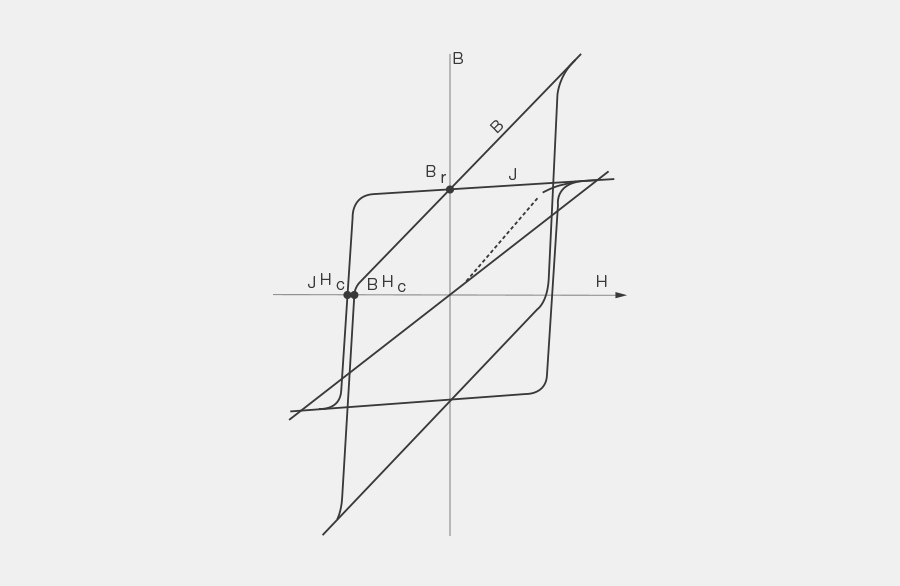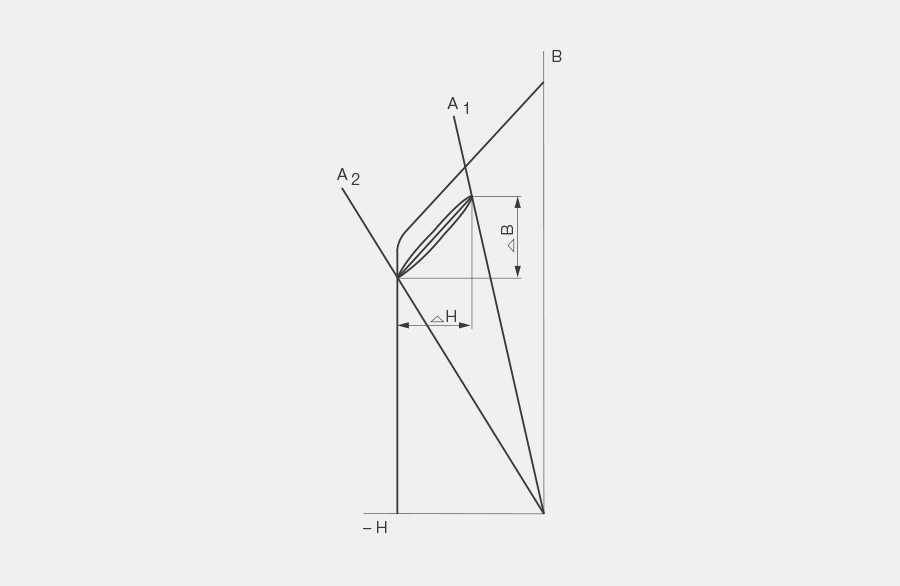This means that certain physical quantities have different values in different directions. With anisotropic hard ferrite magnets, the magnetic powder is aligned in a strong magnetic field during the pressing process. Higher magnetic values result in the direction of this magnetic field than in the direction transverse to it. See also preferred direction.
Straight working line
Connection line between the working point and the zero point of the coordinate system.
Operating point
This is the point on the demagnetising curve who-se allocated B and H values determine the calcu-lation. As a general rule: the longer the magnet is in the direction of magnetisation, the higher the operating point will be. In a closed magnetic cir-cuit, out of which no field exits, the operating point would be on the B-axis. The B-value then equals the Br-value (remanence). Please cf. dimensional ratio.
Barium
Chemical element of group II (alkaline earth metals). The most important mineral is barite.
It is added to iron oxide in the form of barium carbonate during magnet production and results in the compound BaFe12O19 (barium ferrite) during presintering.
(BH)max. (energy density)
Largest possible product of B and H within the demagnetization curve. The higher the (BH) max-value of a material, the smaller the magnet volume required for a specific task can be, all other things being equal.
Curie temperature
The temperature at which a ferromagnetic material loses its magnetism. Named after Madame Curie.
Density
(Specific weight) expressed in g/cm3 or kg/dm3.
Dimension ratio
Height of a cylinder magnet to the diameter. This ratio is important for so-called open magnets. These are magnets without iron pole shoes. The curve sheet shows the H:D values, so that the apparent remanence valid for each H:D value can be read off. If the H:D ratio is very small (from 0.3), these values are only approximate values determined by measurement. An exact calculation is only possible on ellipsoids.
Operating temperature
Highest temperature to which a magnet can be exposed without leaded magnetization losses.
Energy density
Product of magnetic induction and of the field strength H. Shown as an inscribed rectangle under the demagnetisation curve. See also (BH) max. value.
Demagnetization
Product of magnetic induction and
of the field strength H. Shown as an inscribed rectangle under the demagnetisation curve. See also (BH) max. value.
Demagnetization curve
The part of the hysteresis loop that runs in the second quadrant of a rectangular cordinaceous system. The course of the demagnetization curve and its final values Br (remanence) and Hc (coercivity) characterize the essential magnetic properties of a permanent magnet.
Density of flux
The density of the magnetic line of flux (please see also Tesla).
B=Magnetic flux / Coss-sectional area
Flux density meter (Gaussmeter)
To measure the density of flux. This measuring device works with a Hall probe and directly indicates the magnetic density of flux without movement of the probe.
Fluxmeter
To measure the magnetic flux. Formerly a sensitive magnetoelectric instrument without recoil device of the measuring system, with the help of which the magnetic flux could be determined, largely indepentently of the rate of motion of an exploring coil. Modern flux meters work with operational amplifiers instead of mechanical measuring devices.
Gauss
Unit expressing the density of flux according to the Gaussian system of units
1 Gauss ≅10–4 Tesla
1 mT ≅ 10 Gauss
The Gaussian system of units is named after the mathematician Friedrich Gauss.
Hard ferrite
Barium, strontium or lead-ferrite in the chemical composition of MeO·6Fe2O3. being a metal oxyde. All permanently magnetic hard ferrites are hexagonal, e.g. BaO·6Fe2O3 or SrO·6Fe2O3.
The hysteresis cycle
This indicates the course of the magnetic induc-tion as a function of the field force H. J = f (H), or B = f (H), in the second of these examples, the external field in the B-value is included. When magnetised for the first time, B, respectively J, ascends on a so-called virgin curve. Please see graph next to coercive field force.
Induction
The unit Tesla (T). Magnetic induction means, the magnetic order caused (induced) by an external magnetic field of a ferromagnetic material.
Irreversible
Means irreversible or impossible to repeat. In the case of an irreversible alteration, e.g. caused by influences of temperature, the magnetic values do not revert to their original values if the original tmperature is regained.
Isotropy
The equality of physical (here magnetic) properties in all directions.
Coercive field force
The unit of coercive field force is indicated by kA/ m or A/cm. It is the field force Hc, which causes the magnetisation of ferro- magnetic material, which had previously been magnetised up to saturation point, to revert to zero.
The two coercive field forces to be distinguished are JHC and BHC. This distinction is of technical importance in the case of all magnets with a large coercive field force and small remanence. The coercive field force JHC is determined by the hysteresis cycle.
J = f (H)
f (H) = function of H

Lines of force
Well-known and often-used description of the magnetic lines of force which can be made visible by e.g. iron shavings.
Air gap
Space between the poles of a magnet or a magnet system which contains a magnetic field. The narrower the air gap the more homogeneous the field is.
Magnetic flux
Product of magnetic induction x area = B x A
1 Vs = 108 Maxwell = 1 Weber
1 Maxwell = 10 –8 Vs
Magnetising
To magnetise, an external field must be provided, which in the case of hard-ferrite magnets should, at least, have three times the coercive field force J<sup>H</sup>C. The magnetising period can be very short. Without iron pole piece, an impulse of less than one millisecond will suffice.
Maxwell
Unit for the magnetic flux in the Gaussian system of units – please see also magnetic flux – The Maxwell unit is named after the British physicist James Maxwell.
Effective flux
The fraction of the magnetic flux which flows through the effective air gap.
The magnetic flux which does not flow through the effective air gap is called stray flux.
Oersted (Oe)
Obsolete unit for the magnetic field intensity in the Gaussian system of units. Named after the Danish physicist Hans Christian Oersted. 1 Oe = 0,796
A/cm
Oxide magnet
Hard-ferrite magnet made of ceramic magnetic material, e.g. barium- or strontium-ferrite.
Permanent magnet
A magnet (permanent magnet), which totally or partially retains its magnetism after previous magnetisation. Present-day permanent magnetic materials are many times superior in their coercive field force, and therefore more stable than magnets of a few decades ago.
Permeability
«Magnetic permeability» or «conductibility». The permeability of ferrite-magnets is only slightly superior to that of air, however, in the case of e.g. soft iron, it can be superior by a thousand or more times.
Relative permanent permeability
Corresponds approximately to the reversible permeability and indicates the ratio ∆B to ∆H in the following graph. Out of this results the inclination
of the reiteration curve. This means, the inclination of the curve on which a magnet, e.g. after ope-ning and closing of a magnetic circuit, recovers. The operating point in the open system should be situated above the kink of the curve. To achieve a better understanding of relative permeability, the operating point in the picture has been placed be-low the kink of the curve.
( ∆ = Delta)

Remanence
Br is indicated in Tesla (T) or millitesla (mT). Remaining magnetisation in magnetic material, which has been magnetised up to saturation point, in a closed circuit. Apparent remanence refers to the value which results from a partially open magnetic circuit.
Reversible
Reversible or recursive. A reversible conduct of temperature e.g. means that a magnet, after heating up and subsequent cooling down to its initial temperature, regains its initial value.
Shearing
Angle of the straight operating line, e.g. by mans of opening or closing of a magnetic circuit.
Strontium
Chemical element of the ll. group (alkaline earth matals). It is found in the minerals strontianite or cobalt. Strontium is added in the shape of strontium carbonite instead of barium, and results in hard-ferrite magnets with a particularly high coercive field force.
Temperature coefficient
ndicates the alteration of remanence and coer-cive field force, depending on temperature, in magnetic materials.
Tesla
Unit of the magnetic density of flux, respec-tively the magnetic induction.
1 Tesla = 1 Vs/m2 = 10’000 Gauss
The Tesla unit is named after Nicola Tesla.
Preferred direction
The direction in which a magnet reaches its optimum values. In the case of ring and cylindrical magnets, the preferred direction is axial. In the case of square magnets it is the height. In the case of shell magnets (segments) diametrical or radial. In the case of hard-ferrite magnets, the preferred direction is generated by means of compression of a flaky powder in the magnetic field.
Weber
Unit referring to the magnetic flux
1 Weber = 1 Vs = 10 –8 Maxwell
The Weber unit is named after professor Wilhelm Weber.

